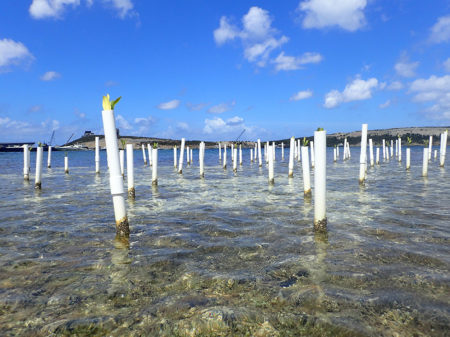
Kippy Gilders shares her experience working for Environmental Protection in the Caribbean (EPIC) restoring the native biodiversity of three disturbed sites on St. Maarten after the devastating impacts of Hurricane Irma in September 2017 – read on to find out more about the challenges faced and the results of their work.
Sweating in the hot summer sun, I wondered what I was doing clambering through thick brush instead of relaxing on a beautiful beach. In front of me is Dr. Ethan Freid, the head Botanist of the Leon Levy Preserve on Eleuthera in The Bahamas. He is skillfully ducking under and climbing over tree branches while I can hardly keep my balance and feel a bit like a giraffe attempting an intricate gymnastics routine. Dr. Freid is happily rattling off plant names while I attempt to make smart remarks and mentally store the new information. Where am I and how did I get here?
So Far, So Good
Having recently graduated and returned home to St. Maarten, I was thrilled and anxious to have been offered the position of Project Coordinator for a biodiversity restoration project with Environmental Protection in the Caribbean (EPIC) Foundation in March 2017. The goal of the project, funded by the BEST 2.0 programme, was to encourage native biodiversity to flourish by removing invasive botanical species and planting 500 native trees between two terrestrial sites and 300 mangroves at one coastal site. In addition, the projected also aimed to increase the awareness and appreciation for local biodiversity conservation though a combination of community and school volunteer opportunities and presentations. With the project set to start in July 2017, I diligently started preparing for the initial biodiversity assessments. All the necessary steps and planning were put into place to ensure a smooth running of the project. What could go wrong!?
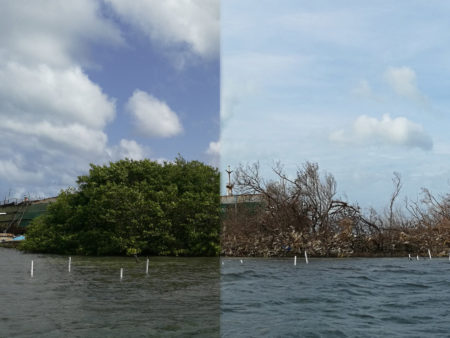
The elaborate giraffe gymnastics occurred in July 2017 when Dr. Freid joined us to conduct the initial botanical assessments of the two terrestrial sites. The project aimed to use the novel PVC encased method to plant the young mangrove propagules- a method that was new to me. To get a feeling for the technique (and to avoid any embarrassing mistakes with the planting volunteers!), it was decided to make 12 test encasements and place these at the site. Meanwhile the 500 terrestrial plants had been ordered with a local nursery and the mangrove stands were beaming with healthy propagules ready for planting. Things were right on track!
The Intensity of Irma Approaches
Then, whispers of an impending hurricane started to circulate. At first the usual optimism that perhaps the storm will dissipate keeps residents from starting the necessary preparations. However, it quickly become clear that there was nothing “normal” about Hurricane Irma. Her intensity doubled overnight and meteorologists were predicting a direct hit. We did what little preparations we could to protect our project and then battened down. We all remained positive and hoped for a shift north or south. But then it was confirmed. Direct hit. Category 5. Biggest storm seen in the Atlantic.
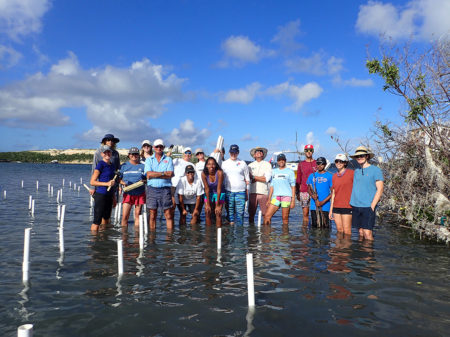
With a tired sigh of relief, Irma passed and the winds decreased. With roads blocked by power poles, boats, and other debris, I jumped on my bike with adrenaline coursing through every possible vein of my body. I saw the complete devastation of my country while en-route to the EPIC office to assess damages. Roof, walls, windows of our office and staff housing… gone. Miraculously, our generous funders would secure funds if we felt that objectives could still be met. As the streets were cleared, we visited the sites. All the hillsides appeared burnt, as if not a single leaf had survived the storm. This was no exception at our two terrestrial sites. Previously large native trees that would be the shade-bearing centerpieces of restoration efforts were torn out by the roots or were diminished to merely a meter or two in height. The same terrestrial sites that once required giraffe gymnastics to traverse could now be easily navigated by the most unskilled of giraffes.
Survival in a Battered Landscape
Hopes waning, I jumped into a kayak and paddled to the coastal site. From the distance I could see that all the mature mangrove stands were nothing more than bare sticks. For sure not a single PVC encasement had survived. When that first glimpse of a thin white pipe became apparent, there it was again, the adrenaline. Had the encasements survived? Despite the total devastation of the mature mangrove stands, 10 of the 12 pipes were still in place and 5 contained propagules. With their first leaves! If any method could ensure high survival rates at this site, it would be the PVC encasement method! As if powered by jet fuel, I kayaked back to land and shared the happy news with the rest of the team and posted to our social media accounts using spotty data connections. Perhaps it was due to the mind set of “the worst has already happened, it can only get better from here” or perhaps all that adrenaline, and we said: Let’s do it, let’s go forth with the project!
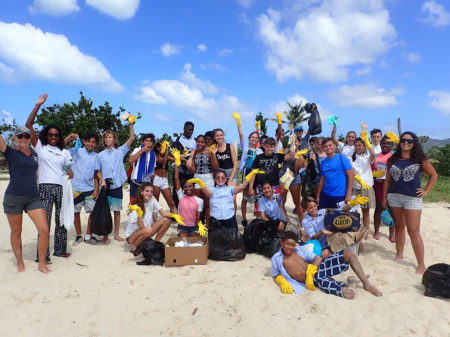
This adrenaline-fueled positivity started to shake as we became aware that all mangrove propagules had blown off the mature stands, the on-island nurseries had been severely impacted, shipping ports were closed and volunteers could have evacuated or their priorities would shift away from volunteering. Almost simultaneously, organizations and generous individual saw our social media posts and offered funding to continue with and expand on planned restoration work, the site owners responded positively about resuming restoration work, ports began to re-open, shipping started to trickle in, nurseries and landscaping companies resumed operation, and increasing amounts of volunteers started to attend our restoration events. This allowed us to increase the amount of volunteer events to further the project goals.
Logistical Challenges Abound . . .
With two rounds of funding from the BirdsCaribbean Hurricane Relief Fund we were able to repair damages to a bird blind overlooking Little Bay Fresh Pond (a recognized Important Bird Area or IBA), pay technicians for extra hours of labor, buy and ship 300 mangrove seedlings, and continue to provide food and drinks during the increased amount of volunteer opportunities.
Along the way we experienced some hurdles, mainly the procurement of the 500 plants which now became more complicated and expensive, and ensuring adequate water irrigation to the sites. Since the aim of the project was to increase native biodiversity, we sourced the plants from multiple nurseries to ensure a higher final diversity of plant species added to the sites. However, this meant that not all 500 plants arrived at once and it became our responsibility to care for the plants we had already received before hiring the landscaping company to do the final planting. In some cases, site owners were also preoccupied with their own recovery efforts or experienced damages to machinery. Thus, irrigation installment was delayed or altogether no longer possible. Meanwhile EPIC staff and dedicated volunteers watered the plants by hand.
. . . But a Win for Increased Biodiversity
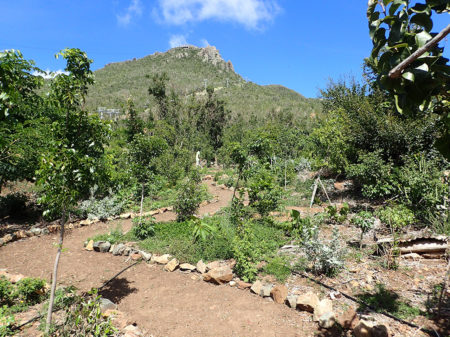
Despite the multiple challenges faced along the way, final assessments showed that plant species diversity increased from pre-restoration to post-restoration by 25 to 35 different species at the site located in Cay Bay and 41 to 52 different species at the site located on Sentry Hill. The post-restoration survival rates were found to be up to 96.1% at Sentry Hill, 89.6% at Cay Bay and 84.5% at the coastal site on Little Key island. These results point to an increased biodiversity at the restoration sites and, once the trees mature, an increased carbon sequestration capacity.
Sometimes the greatest challenges bring the sweetest rewards and this was definitely the case for this project. The replanting of trees brought hope to EPIC staff and residents after Hurricane Irma and as a result a warm community of dedicated volunteers was created. During this project a nature trail was created within the restoration site at Sentry Hill. Along the trail, informative signs highlight the newly planted trees and the restoration efforts. This trail is the first of its kind on St. Maarten and serves as a beacon of hope for future conservation of the island’s natural habitats. We are grateful for the assistance we received from BirdsCaribbean, BEST 2.0, generous individuals and all the organizations that helped us along the way.
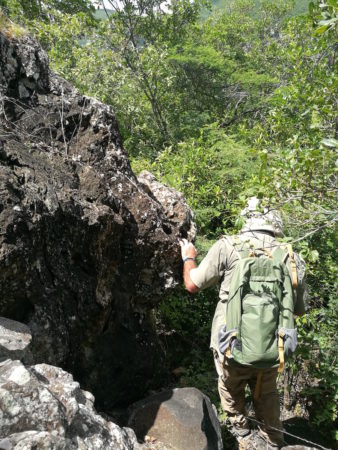
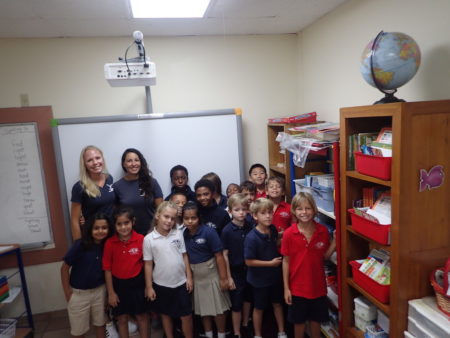
Students of all ages were Introduced to biodiversity and the importance of preserving native habitat.
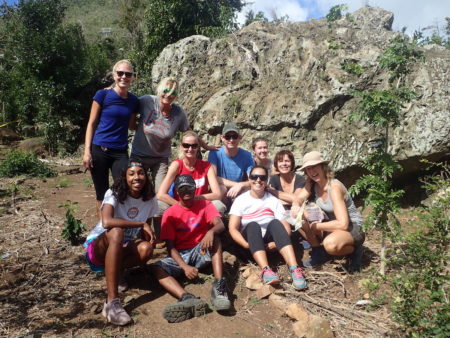

Beautifully written my giraffe xxx ridiculously proud of the work you do for your beloved Island.
Thanks, Petra, we are proud of Kippy and her team also!